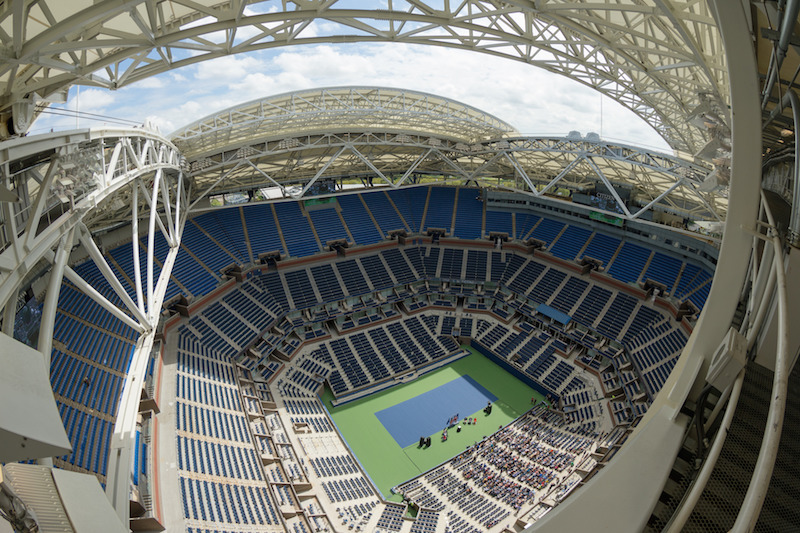As the U.S. Open Grand Slam tennis tournament in New York moves into its second week, the massive retractable roof over the 23,711-seat Arthur Ashe stadium has been drawing oohs and aahs from players and fans alike.
The $150 million roof addition is part of a $550 million renovation of the Billie Jean King National Tennis Center in Flushing, Queens. The roof itself was five years in the making, and posed several structural and engineering challenges to the Building Team, which included the architect Rossetti, the engineering firm WSP | Parsons Brinckerhoff, and the general contractor Hunt Construction Group.
This morning, BD+C interviewed WSP | Parsons Brinckerhoff execs Ahmad Rahimian, P.E., SE, F.ASCE, director of Building Structures; and Yoram Eilon, P.E., Senior Vice President of Building Structures, about this project.
Rahimian noted that any stadium construction or renovation is complicated. This one, though, was unique in several ways. For one thing, there was no precedent to draw upon in the tennis world, as Arthur Ashe is by far the largest stadium on the tour. And that facility, which opened in August 1977, wasn’t designed to include a roof.
Rahimian said that the U.S. Tennis Association (USTA), which owns and operates the venue and annual event, actually started thinking about a roof three years after the stadium opened. Those plans became more urgent in 2008, when rain interfered with the completion of some matches. Since then, rain has been a perennial threat, and occasional impediment, to the tournament’s scheduling. Design discussions for a roof began around 2011, he said.
Given the stadium’s age and structural condition, the Building Team concluded that the best solution would be to build a freestanding structure for the retractable roof that doesn’t touch the stadium itself. (There’s a 15-inch gap between the stadium and the roof pavilion.)
That roof structure sits on eight super-steel columns and 16 great brace angles that rise 125 feet above ground level, and support an 80-foot-high Teflon-covered membrane and two 500-ton panels that move back and forth over a 62,500-sf opening.
The retractable panels move on wheel assemblies mounted on rails, and can be opened or closed by cables and winches in only seven minutes.
The National Tennis Center is located in a marshy part of Queens, so the Building Team had to find answers to soil issues in order to support a roof pavilion that would weigh 6,500 tons. The steel columns are organized in an octagonal pattern that corresponds to the shape of the stadium. Each column is mounted on a concrete pier that spreads the weight load of the pavilion onto an underground concrete slab. That platform is supported by pilings that go as deeply as 180 feet into the ground.
Eilon noted, though, that this wasn’t a simple drilling job, as there are massive amounts of utilities infrastructure underground that needed to be circumvented or rerouted, not to mention the subway and Long Island Railroad systems nearby.
In addition, construction shut down during the two weeks of the tournament, which meant that cranes had to be taken down or relocated.
(Despite New York’s reputation for being a difficult place to get construction done, Rahimiam and Eilon said the city wasn’t at all intrusive. “I think they understood the significance of this to the city,” says Eilon.)

Even when the roof is open, 60% of the stadium's 23,771 seats are shaded. Image: USTA/Jennifer Pottheiser
Even when the roof is open, at least 60% of the stadium seats are shaded. To mitigate condensation and to ventilate the stadium when the roof is closed, the Building Team installed 16 air diffusers along a six-foot-wide duct that encompasses the top of the stadium, the WSP execs confirmed. As cooled air drops into the bowl of the stadium, it’s expelled by mechanical fans.
Rahimian and Eilon say that despite all this HVAC equipment, the stadium is relatively quiet when the roof is closed, although that enclosure does tends the magnify ambient sounds from the audience, which at the U.S. Open are pretty noticeable to begin with.
USTA had budgeted about $100 million for the roof project, but dealing with structural support, condensation, and ventilation tacked on another $50 million to the price tag, says Rahimian.
WSP | Parsons Brinckerhoff is involved in other facets of the National Tennis Center’s renovation, which will include an expanded Grandstand stadium. Whether other sports stadiums embrace retractable roofs, though, remains to be seen. Roland Garros, the location of the French Open in Paris, intends to install a retractable roof to cover its Court Philippe Chatrier, although construction has been pushed back to 2020 at the earliest, according to Tennis Magazine.
Rahimian believes retractable roofs help venues to “justify” their brands, and he expects more projects like these in the future. “I think it’s a trend.”
Related Stories
Designers | Jul 20, 2023
Mary Cook Associates brews up coffeehouse-inspired apartment community
The MCA design team worked closely with the developer and design architect to create an interior concept inspired by Decatur, Ga.’s, tree-lined streets, boutique retail, and vibrant restaurant and coffee shop scene.
Healthcare Facilities | Jul 19, 2023
World’s first prefab operating room with fully automated disinfection technology opens in New York
The first prefabricated operating room in the world with fully automated disinfection technology opened recently at the University of Rochester Medicine Orthopedics Surgery Center in Henrietta, N.Y. The facility, developed in a former Sears store, features a system designed by Synergy Med, called Clean Cube, that had never been applied to an operating space before. The components of the Clean Cube operating room were custom premanufactured and then shipped to the site to be assembled.
Performing Arts Centers | Jul 18, 2023
Perelman Performing Arts Center will soon open at Ground Zero
In September, New York City will open a new performing arts center in Lower Manhattan, two decades after the master plan for Ground Zero called for a cultural component there. At a cost of $500 million, including $130 million donated by former mayor Michael R. Bloomberg, the Perelman Performing Arts Center (dubbed PAC NYC) is a 138-foot-tall cube-shaped building that glows at night.
Codes and Standards | Jul 17, 2023
Outdated federal rainfall analysis impacting infrastructure projects, flood insurance
Severe rainstorms, sometimes described as “atmospheric rivers” or “torrential thunderstorms,” are making the concept of a “1-in-100-year flood event” obsolete, according to a report from First Street Foundation, an organization focused on weather risk research.
Multifamily Housing | Jul 13, 2023
Walkable neighborhoods encourage stronger sense of community
Adults who live in walkable neighborhoods are more likely to interact with their neighbors and have a stronger sense of community than people who live in car-dependent communities, according to a report by the Herbert Wertheim School of Public Health and Human Longevity Science at University of California San Diego.
Contractors | Jul 13, 2023
Construction input prices remain unchanged in June, inflation slowing
Construction input prices remained unchanged in June compared to the previous month, according to an Associated Builders and Contractors analysis of U.S. Bureau of Labor Statistics Producer Price Index data released today. Nonresidential construction input prices were also unchanged for the month.
Government Buildings | Jul 13, 2023
The recently opened U.S. Embassy in Ankara reflects U.S. values while honoring Turkish architecture
The U.S. Department of State’s Bureau of Overseas Buildings Operations (OBO) has recently opened the U.S. Embassy in Ankara, Turkey. The design by Ennead Architects aims to balance transparency and openness with security, according to a press statement. The design also seeks both to honor Turkey’s architectural traditions and to meet OBO’s goals of sustainability, resiliency, and stewardship.
Affordable Housing | Jul 12, 2023
Navigating homelessness with modular building solutions
San Francisco-based architect Chuck Bloszies, FAIA, SE, LEED AP, discusses his firm's designs for Navigation Centers, temporary housing for the homeless in northern California.
Sponsored | Fire and Life Safety | Jul 12, 2023
Fire safety considerations for cantilevered buildings [AIA course]
Bold cantilevered designs are prevalent today, as developers and architects strive to maximize space, views, and natural light in buildings. Cantilevered structures, however, present a host of challenges for building teams, according to José R. Rivera, PE, Associate Principal and Director of Plumbing and Fire Protection with Lilker.
Building Owners | Jul 12, 2023
Building movement: When is it a problem?
As buildings age, their structural conditions can deteriorate, causing damage and safety concerns. In order to mitigate this, it’s important to engage in the regular inspection and condition assessment of buildings for diagnosis.

















